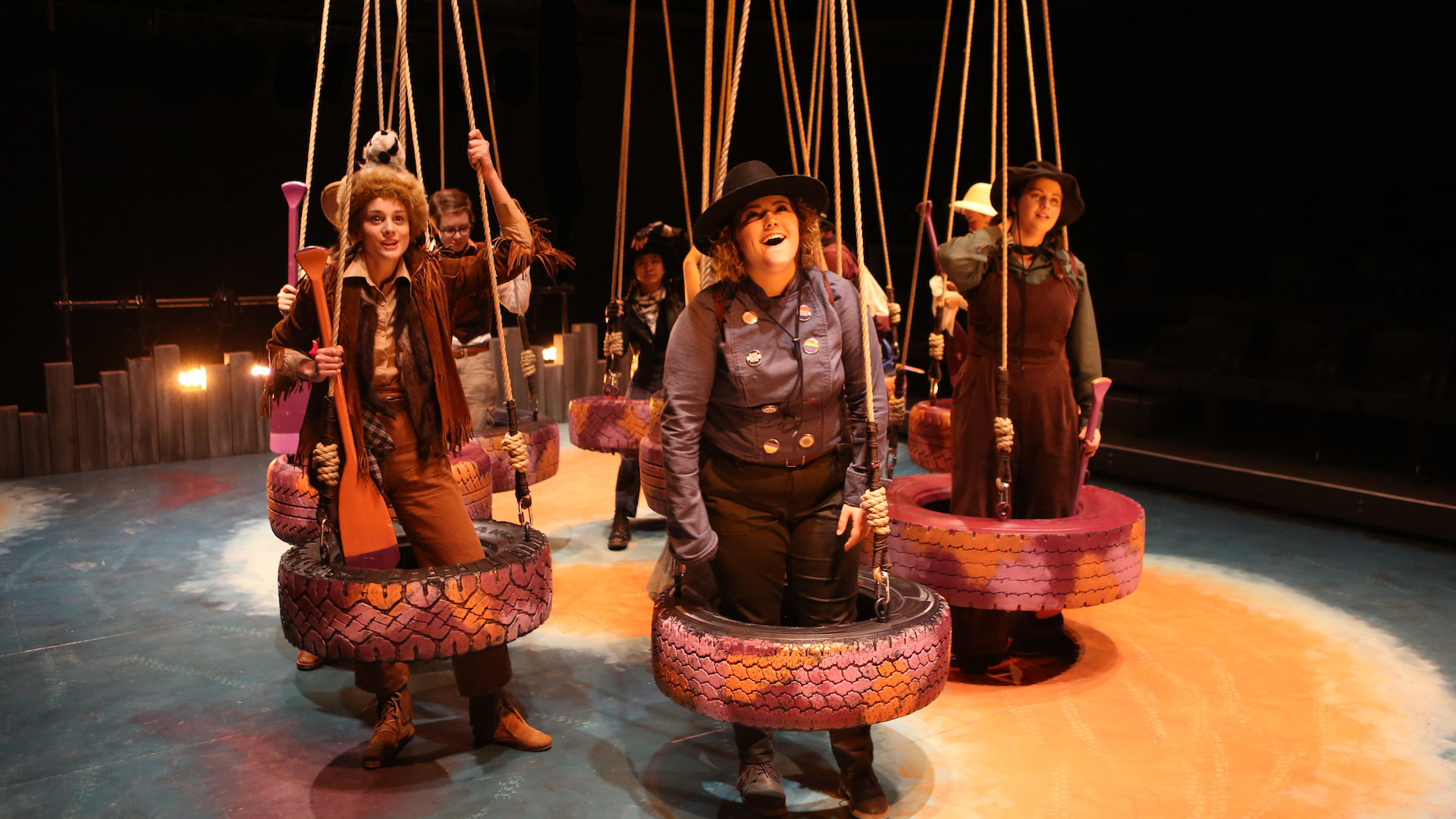
Photo: Sue Kessler
By Philip Merrick
Who gets to write history?
John Wesley Powell, the one-armed leader of an 1869 geographic expedition through the Grand Canyon, seemed to think he did. His published accounts of the expedition through the newly acquired U.S. territory became a classic of American exploration literature. The trip was so dangerous that by the end of the expedition, four out of ten members had left the party to seek safety on land. The crew’s harrowing journey, immortalized by Powell’s words, inspired a 1960 film, and he eventually got a museum and a lake named after him in Arizona.
But in this irreverent, relentlessly modern play by Jaclyn Backhaus, directed by Nina Slowinski ’19, Powell doesn’t get the final say. The cast of Men on Boats is composed of transgender, nonbinary and female actors, some of whom are people of color—and none of whom would have been invited on Powell’s expedition. Instead of cisgender white men climbing cliffs, naming mountains, and committing other acts of daring, we are presented with a cast of people who look nothing like the original explorers. The result is a show that manages to be simultaneously a story of danger and survival and a playful comedy.
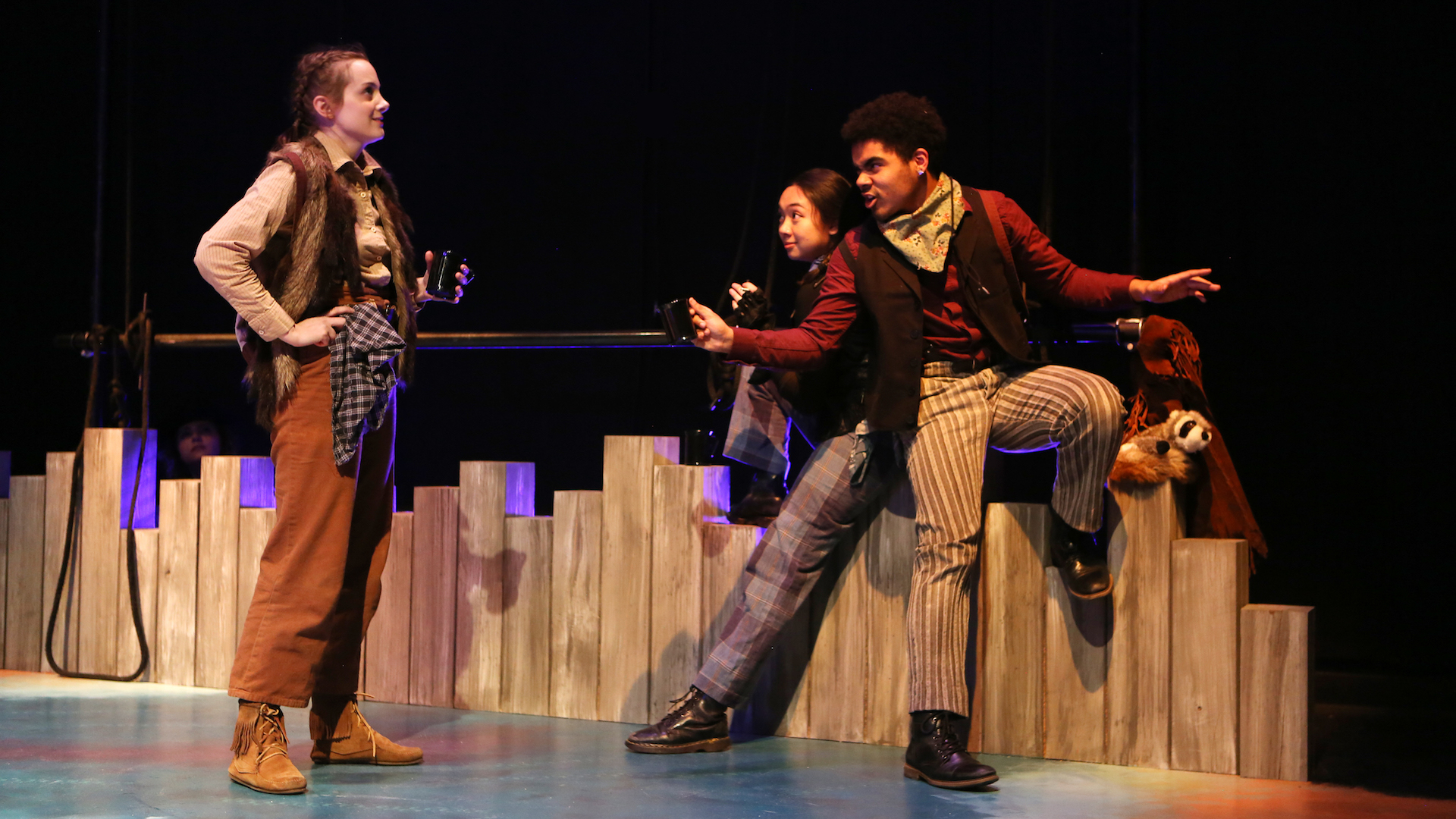
Photo: Sue Kessler
The set, designed by Romi Moors ’19, features a floor swirling with the blue of the rapids and the orange of the Canyon walls, plus two barriers to the left and right of a two-sided audience. But the main attraction has got to be the tire swings: Ten swings of varying size and distance from the ground, painted with splatters of pink and purple, hang from the catwalks on long ropes. As stand-ins for the eponymous boats, the tire swings balance the visceral nature of the rapids with the playful tone of the script, and the result is a production that is funny, fun, and extremely physical.
The rapids are terrifying, exhilarating, and glorious. They are the site of the biggest ups and downs of the play, literally and metaphorically, and the experience of going on this visceral journey alongside the characters is one of the biggest rewards of watching the show. Actors spin, swing, crouch, stand, and cling for dear life on their tire swings, sometimes two or three to a swing. When a character falls into the water (which happens several times), they roll on the ground or spin around with arms flailing until someone pulls them to safety. The adrenaline and the motion sickness of the rapids are palpable from start to finish. The characters are exhausted after every trip, and by the end of the play, the actors surely are as well.
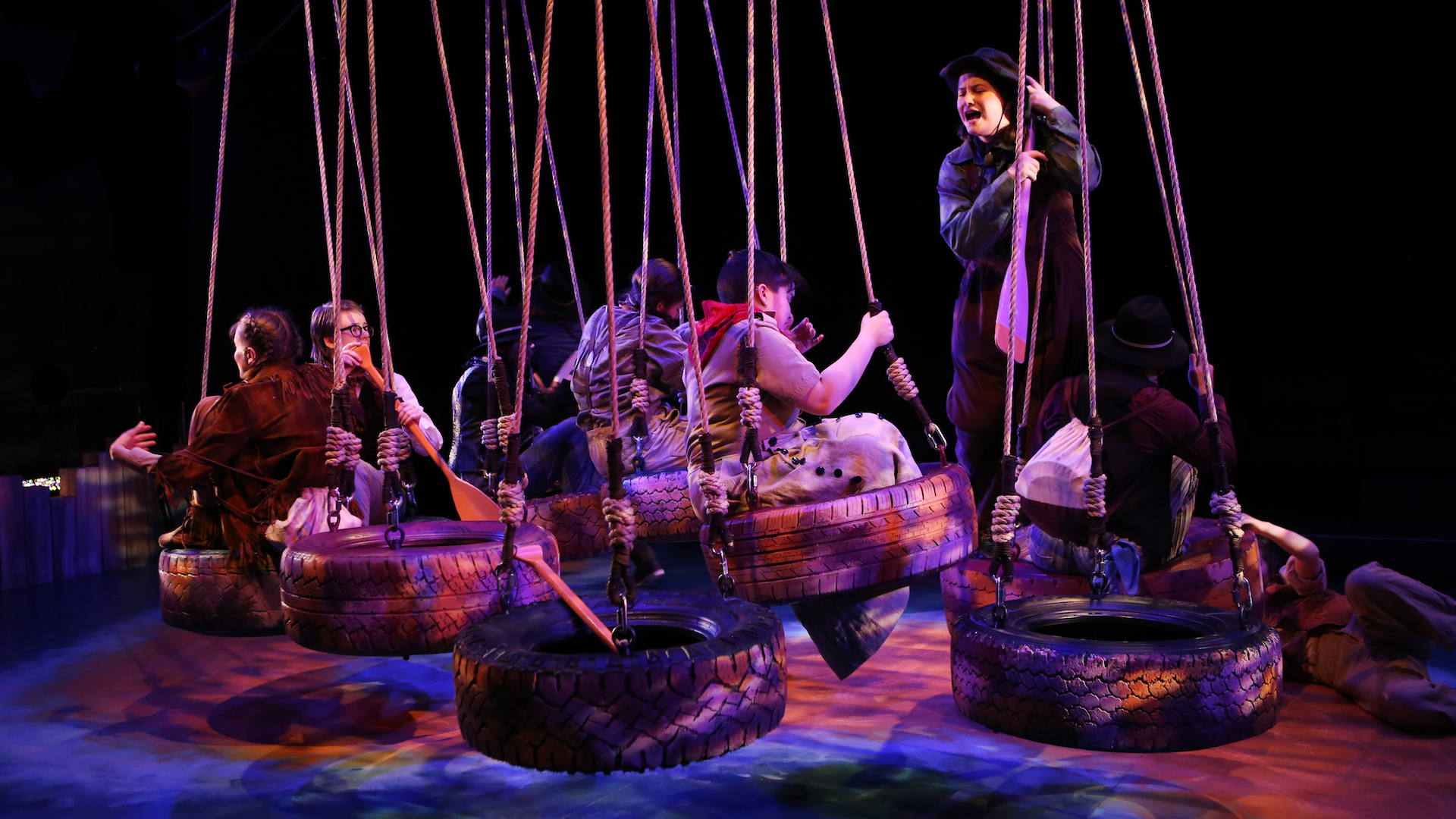
Photo: Sue Kessler
In all this adventuring, the characters perform their masculinity. It’s present in their bravery, their recklessness, their willpower, and their tendency to name everything in sight after themselves. It’s present in the fact that the closest thing to female characters in the play are the boats—the Emma Dean, the Maid of the Canyon, the Kitty Clyde’s Sister. The men in this play try to impress each other, to survive, to gain control. The cast’s performing those men performing masculinity adds equal amounts of wit and criticism to the piece that, especially in an age when Hamilton has taken Broadway by storm, feels urgently contemporary.
The costumes, designed by Julia Guy ‘19, queer the play further by adding a brand of old-school androgyny to the mix. Costumes reflect the styles of the time period and culture but do not reflect the gender binary that was present in the time period. The only two characters dressed in conventional menswear are adventure enthusiast Goodman (CJ Delfino ’22) in a tan safari suit and a British-flag bowtie and cartographer Hall (Basil Lilien ’19) in a neat suit and ascot. Other costumes have elements of male and female clothing styles that make each outfit hard to categorize. The audience witnesses such stage-pictures as team cook Hawkins (Ana-Marie Fama ’21) leaping across the stage in a cargo skort to kill a rattlesnake and young Bradley (Theo Strassel ’22) taking off his “pants” (a long buttoned skirt) to save Powell on a steep climb. This style brings the century-and-a-half-old story into 2019 by planting us firmly in a world where gender works differently. There are even hints of the 21st century in some of the outfits: sly hunter O.G. Howland (Marina Kalaw ’22) wears a leather jacket and the buttons on Powell’s shirt (if you look closely) are an assortment of modern political pins.
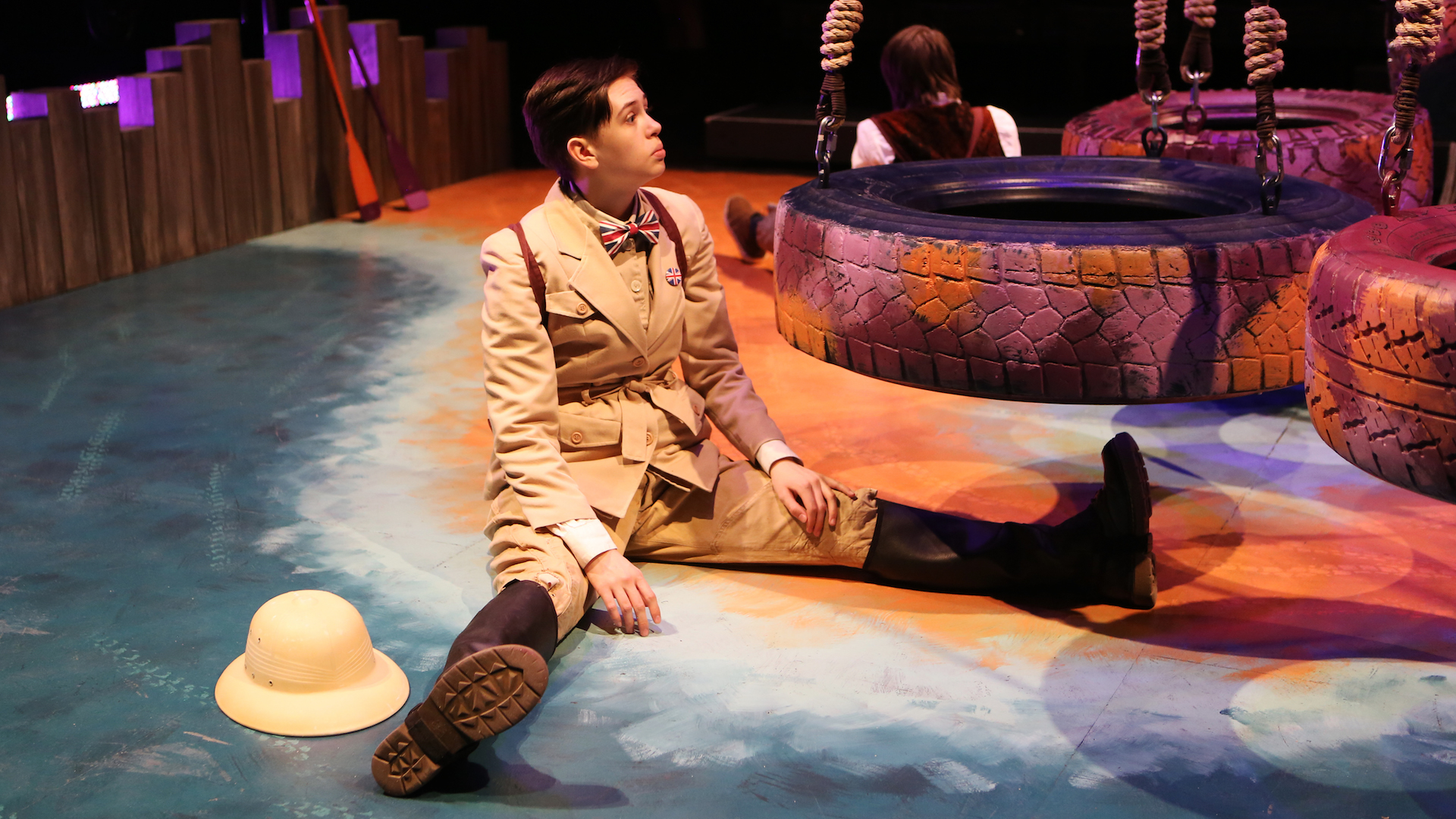
Photo: Sue Kessler
Props, designed by Wynn Lee ’21, contribute to the playful energy of the show. Many of the props are made of felt and actors are able to take advantage of this by, for example, throwing fish at each other during mealtimes (with a cutesy toy fire nearby). One of the best jokes of the show occurs when Sumner (Hanna Yurfest ’20) removes a bright green felt snake from her bag only to then jump with fear when it hits the ground and begins to “hiss”—a sound created by an actor using a shaker egg offstage.
Sound designer Jessie Hamilton ’20 ingeniously sculpts the echoes of the rapids, combining the cascade of water with the swell and rush of a musical underscore. The complexity and richness of the rapids pay off in the emotional highs and lows of the adventure. Lighting by Lea Tanenbaum ’19 is textured and layered, filling out the space with shadows of blue and accents of amber. No matter where we are on the journey, the danger and grandeur of the Grand Canyon is just around the corner.
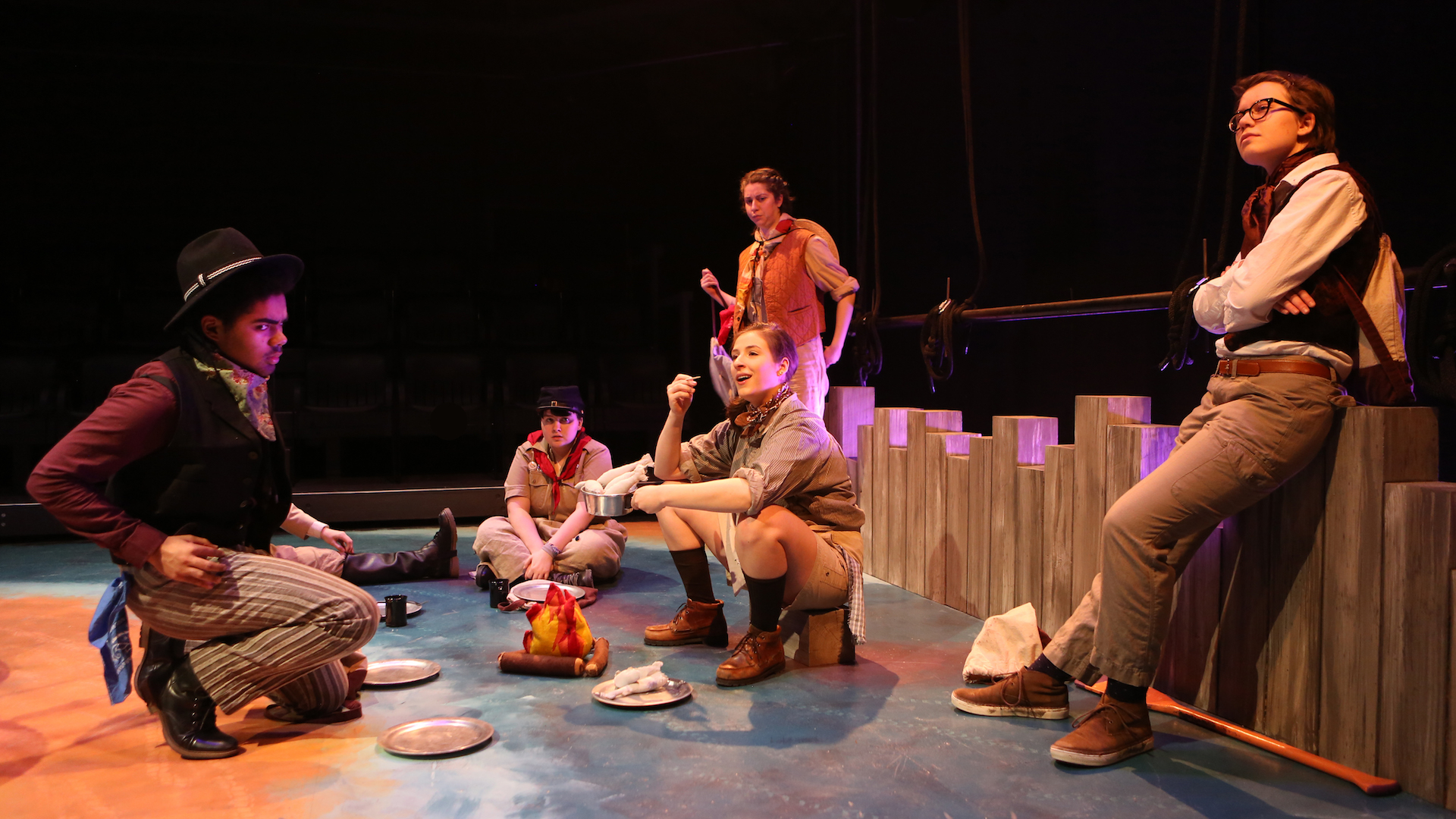
Photo: Sue Kessler
The moment when the characters finally enter the Grand Canyon, as the show nears its end, is one of the most striking images in the entire production. Soft amber and pink tones wash across the stage in a sudden transformation of ruggedness to beauty, from danger to glory. The adventurers have finally gotten a taste of westward expansion and manifest destiny. Seeing that accomplishment in the eyes of a cast of people who have been denied access to it raises the central question of the play: Who deserves the glory of history? Who deserves to be immortalized?
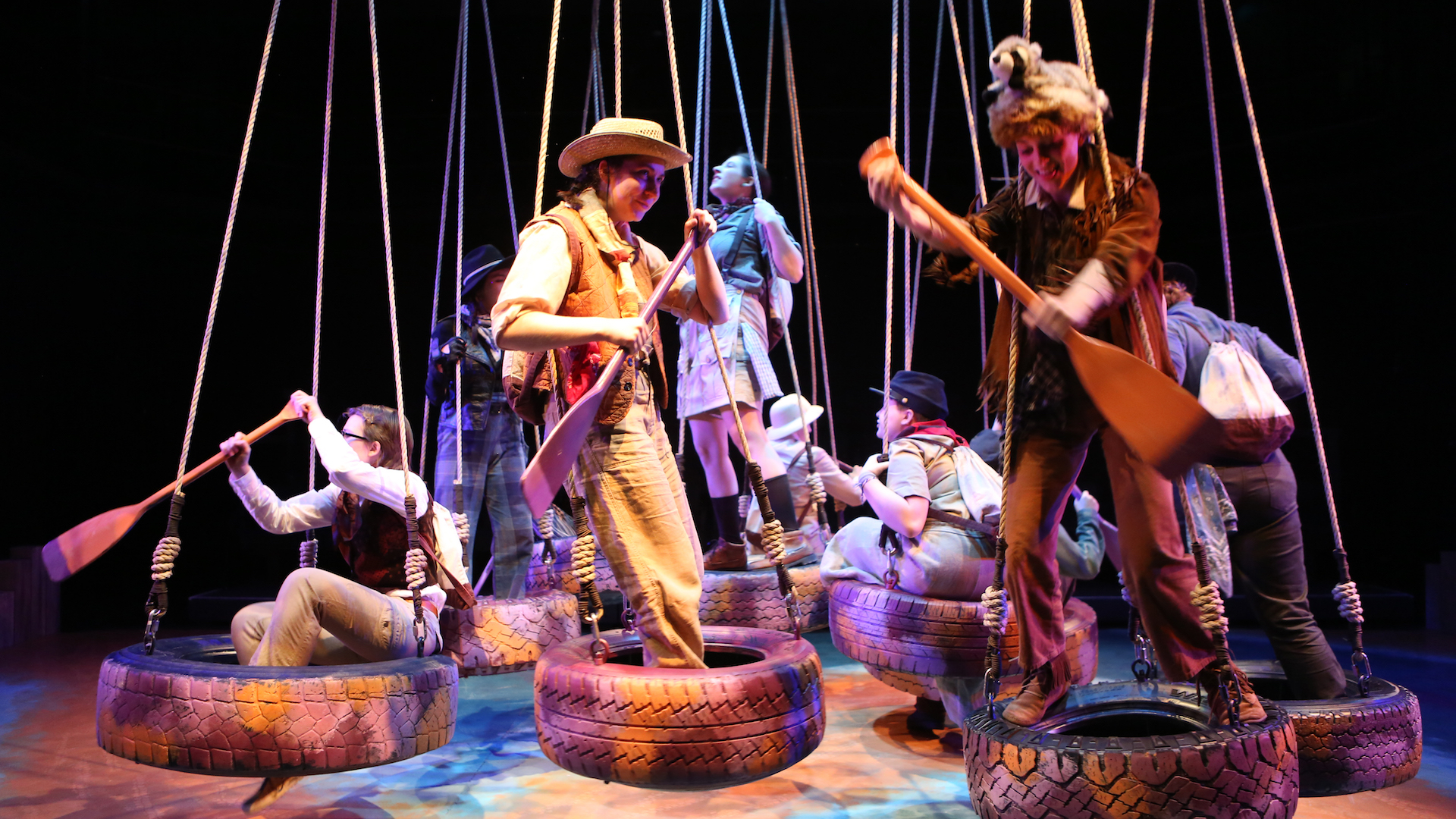
Photo: Sue Kessler
PHOTO GALLERY
PRODUCTION CREDITS
Written by: Jaclyn Backhaus
Directed by: Nina Slowinski ’19
Stage Manager: Emily Hardy ’21
Scenic Design: Romi Moors ’19
Sound Design: Jessie Hamilton ’20
Lighting Design: Lea Tanenbaum ’19
Costume Design: Julia Guy ’19
Hair Designer: L. Esther Hibbs ’20
Dramaturg: Claire Fink ’22
Cast: Sammy Bluth ’19 (Dunn), Emily Cross ’19 (Powell), CJ Delfino ’22 (Goodman/Mr. Asa), Anna Marie Fama ’21 (Hawkins), Marina Kalaw ’22 (O.G./Tsauwiat), Basil Lilien ’19 (Hall), Coco McNeil ’21 (Old Shady), Tatsuya Rivera ’22 (Seneca/The Bishop), Z Strassell ’22 (Bradley), Hanna Yurfest ’21 (Sumner)
Crew: Jared Klein (Technical Director), James Varkala (Assistant Technical Director), Jessica Thomas (Scenic Charge & Technical Assistant), Emily Byrne ’22 (Assistant Stage Manager), Max Clifford ’21 (Assistant Stage Manager/Costume Designer Assistant), Wynn Lee ’21 (Props Master), Bridget Kerr ’20 (Assistant Costume Design), Lucy Holden ’22 (Assistant Hair Design), Jessie Blackman ’20 (Wardrobe Supervisor), JoLynn Dubois ’19 (Makeup Supervisor), August Sylvester ’20 (Master Electrician), Shelby Fairchild ’21 (Assistant Master Electrician), Kate Newhouse ’22 (Light Board Operator), Michael McDonald ’19 (Sound Board Operator)
***
Philip Merrick is a senior theater major and co-editor of the Skidmore Theater Living Newsletter

















